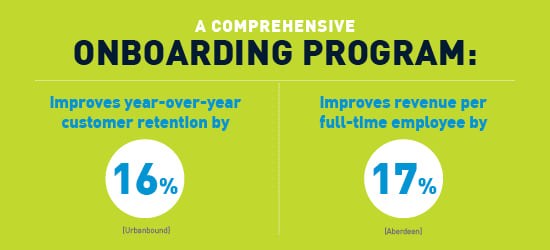Onboarding best practices
Part 4: Onboarding activities that improve job performance
August 22, 2016 | By Leslie Deutsch

Overwhelmed. We’ve all been there—that feeling you get when you start a new job and feel woefully uncertain of what the next few months will bring, no matter how much experience you have. The time it takes for a new hire to acclimatize to their role and corporate culture is risky for everyone involved. Ramping new hires up to productivity quickly helps them gain confidence and makes a big difference in improving individual and team morale, increasing retention and fostering a high-performance culture.
Successful onboarding is the culmination of the work you’ve done in other phases plus a customized productivity plan:
- Reaping onboarding efficiencies through greater automation
- Organizing successful orientations
- A role-specific support plan so your new hires can quickly contribute to business goals
Don't stop onboarding at 30 days
For a new hire, trying to remember everything learned in a traditional onboarding bootcamp is a lot like being a thirsty person trying to drink from a waterfall, but unable to retain enough water to quench their thirst. That’s not to say formal training isn’t needed; it’s an important component of a more comprehensive learning roadmap that also provides real-world context.
The most successful onboarding programs share a common link: they provide clear expectations for what “good enough” looks like at 30-60-90-180-day milestones, and a support plan for how to get there. There are many studies that show that companies with six-month-plus onboarding programs achieve vastly superior business results to shorter ones.
- Managers who engage with the new hire immediately and start setting goals together, coming to a shared commitment on the milestones and describing what success looks like, report higher satisfactionwith onboarding
- Ninety-one percent of new hires are retained in companies where the managers engage with new hires right away, vs. 30 percent of those in organizations with task- and form-focused onboarding practices

Failure can be desirable
After 30 days we tend to let the bird leave the nest and fly solo. In reality, the time it takes for employees to mature in the job will differ for each individual. For new hires, the pressure to get it right the first time is high and can lead to fear of stretching themselves to take risks. To round out the more formal aspects of training, I strongly recommend coaching and lots of “safe” practice opportunities to get the most out of those new on-the-job experiences, as well as assigning a peer mentor to model internal best practices.
I like to incorporate planned activities throughout the role-based ramp-up process to give new hires a dry run with experienced colleagues before going live with customers or other stakeholders (Agile practitioners refer to this as a “kata”). Failing in a safe environment teaches new hires what to do—and what not to do. In turn, this gives them the chance to master critical skills before they face complex on-the-job situations.
Socialization reinforces success
Networking to build relationships within a team and across cross-functional departments has been proven to improve a new hire’s productivity and engagement. Managers can easily incorporate networking opportunities into a new hire’s ramp-up plan, and encouraging more senior team members to become peer mentors helps develop their leadership abilities.
Consider incorporating these steps:
- Build a buddy system: Activities that pair new hires and experienced team members help forge relationships and build the trust necessary for high performance, while boosting loyalty
- Identify go-to people: Be sure the employee meets the leadership and project teams, support personnel and other key cross-functional colleagues to build their informal network

Track what's working—and what's not
Solicit positive and negative feedback from all involved in onboarding, and use that to improve the onboarding experience for the new hire and their manager. At a macro level, your onboarding program needs to be flexible to shift as business priorities change. At a micro, or employee, level, ongoing communication and collaboration creates more meaningful work by encouraging reflection, personal growth and advancing career opportunities.
Your talent can achieve peak performance
We can help.
